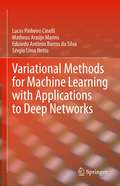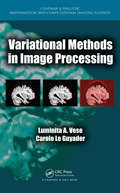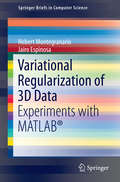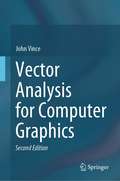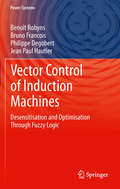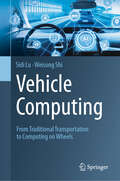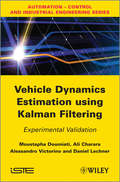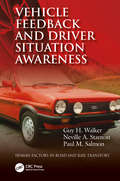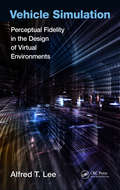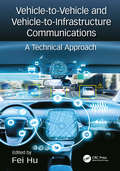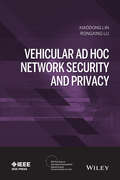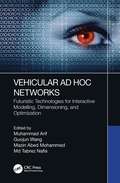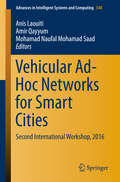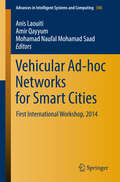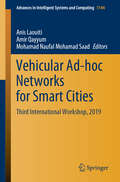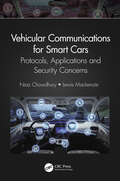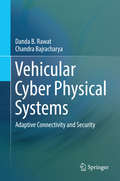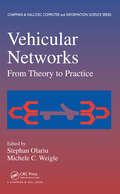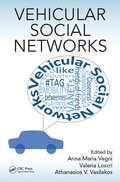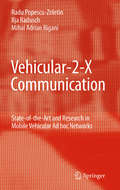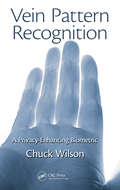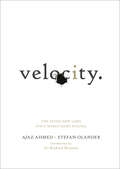- Table View
- List View
Variational Analysis and Aerospace Engineering: Mathematical Challenges for Aerospace Design
by Giuseppe Buttazzo Aldo FredianiThis volume consists of papers presented at the Variational Analysis and Aerospace Engineering Workshop II held in Erice, Italy in September 2010 at the International School of Mathematics "Guido Stampacchia". The workshop provided a platform for aerospace engineers and mathematicians (from universities, research centers and industry) to discuss the advanced problems requiring an extensive application of mathematics. The presentations were dedicated to the most advanced subjects in engineering and, in particular to computational fluid dynamics methods, introduction of new materials, optimization in aerodynamics, structural optimization, space missions, flight mechanics, control theory and optimization, variational methods and applications, etc. This book will capture the interest of researchers from both academia and industry.
Variational Bayesian Learning Theory
by Masashi Sugiyama Shinichi Nakajima Kazuho WatanabeVariational Bayesian learning is one of the most popular methods in machine learning. Designed for researchers and graduate students in machine learning, this book summarizes recent developments in the non-asymptotic and asymptotic theory of variational Bayesian learning and suggests how this theory can be applied in practice. The authors begin by developing a basic framework with a focus on conjugacy, which enables the reader to derive tractable algorithms. Next, it summarizes non-asymptotic theory, which, although limited in application to bilinear models, precisely describes the behavior of the variational Bayesian solution and reveals its sparsity inducing mechanism. Finally, the text summarizes asymptotic theory, which reveals phase transition phenomena depending on the prior setting, thus providing suggestions on how to set hyperparameters for particular purposes. Detailed derivations allow readers to follow along without prior knowledge of the mathematical techniques specific to Bayesian learning.
Variational Methods for Machine Learning with Applications to Deep Networks
by Lucas Pinheiro Cinelli Matheus Araújo Marins Eduardo Antônio Barros da Silva Sérgio Lima NettoThis book provides a straightforward look at the concepts, algorithms and advantages of Bayesian Deep Learning and Deep Generative Models. Starting from the model-based approach to Machine Learning, the authors motivate Probabilistic Graphical Models and show how Bayesian inference naturally lends itself to this framework. The authors present detailed explanations of the main modern algorithms on variational approximations for Bayesian inference in neural networks. Each algorithm of this selected set develops a distinct aspect of the theory. The book builds from the ground-up well-known deep generative models, such as Variational Autoencoder and subsequent theoretical developments. By also exposing the main issues of the algorithms together with different methods to mitigate such issues, the book supplies the necessary knowledge on generative models for the reader to handle a wide range of data types: sequential or not, continuous or not, labelled or not. The book is self-contained, promptly covering all necessary theory so that the reader does not have to search for additional information elsewhere. Offers a concise self-contained resource, covering the basic concepts to the algorithms for Bayesian Deep Learning;Presents Statistical Inference concepts, offering a set of elucidative examples, practical aspects, and pseudo-codes;Every chapter includes hands-on examples and exercises and a website features lecture slides, additional examples, and other support material.
Variational Methods in Image Processing (Chapman & Hall/CRC Mathematical and Computational Imaging Sciences Series)
by Luminita A. Vese Carole Le GuyaderVariational Methods in Image Processing presents the principles, techniques, and applications of variational image processing. The text focuses on variational models, their corresponding Euler-Lagrange equations, and numerical implementations for image processing. It balances traditional computational models with more modern techniques that solve t
Variational Regularization of 3D Data
by Hebert Montegranario Jairo EspinosaVariational Regularization of 3D Data provides an introduction to variational methods for data modelling and its application in computer vision. In this book, the authors identify interpolation as an inverse problem that can be solved by Tikhonov regularization. The proposed solutions are generalizations of one-dimensional splines, applicable to n-dimensional data and the central idea is that these splines can be obtained by regularization theory using a trade-off between the fidelity of the data and smoothness properties. As a foundation, the authors present a comprehensive guide to the necessary fundamentals of functional analysis and variational calculus, as well as splines. The implementation and numerical experiments are illustrated using MATLAB®. The book also includes the necessary theoretical background for approximation methods and some details of the computer implementation of the algorithms. A working knowledge of multivariable calculus and basic vector and matrix methods should serve as an adequate prerequisite.
Vector Analysis for Computer Graphics
by John VinceThis book is a complete introduction to vector analysis, especially within the context of computer graphics. The author shows why vectors are useful and how it is possible to develop analytical skills in manipulating vector algebra. Even though vector analysis is a relatively recent development in the history of mathematics, it has become a powerful and central tool in describing and solving a wide range of geometric problems. The book is divided into eleven chapters covering the mathematical foundations of vector algebra and its application to, among others, lines, planes, intersections, rotating vectors, and vector differentiation.
Vector Control of Induction Machines
by Bruno Francois Philippe Degobert Benoît Robyns Jean Paul HautierAfter a brief introduction to the main law of physics and fundamental concepts inherent in electromechanical conversion, Vector Control of Induction Machines introduces the standard mathematical models for induction machines - whichever rotor technology is used - as well as several squirrel-cage induction machine vector-control strategies. The use of causal ordering graphs allows systematization of the design stage, as well as standardization of the structure of control devices. Vector Control of Induction Machines suggests a unique approach aimed at reducing parameter sensitivity for vector controls based on a theoretical analysis of this sensitivity. This analysis naturally leads to the introduction of control strategies that are based on the combination of different controls with different robustness properties, through the use of fuzzy logic supervisors. Numerous applications and experiments confirm the validity of this simple solution, which is both reproducible and applicable to other complex systems. Vector Control of Induction Machines is written for researchers and postgraduate students in electrical engineering and motor drive design.
Vegetation Fires and Pollution in Asia
by Krishna Prasad Vadrevu Toshimasa Ohara Chris JusticeVegetation fires are prevalent in several regions of the world, including South/ Southeast Asia (S/SEA). Fire occurrence and spread are influenced by fuel type, topography, climate, weather, and lightning, among others. In S/SEA, human-initiated fires are responsible for most of the incidents in addition to natural factors. Through biomass burning, vegetation fires can emit large quantities of greenhouse gases and air pollutants such as CO2, CO, NOx, CH4, non-methane hydrocarbons, and other chemical species, including aerosols that can affect air quality and health at both local and regional scales. Moreover, biomass burning pollutants can travel long distances and impact regional climate. Therefore, quantifying vegetation fires and their impacts is critical at different spatial scales. This book includes contributions from renowned researchers from the USA and South/ Southeast Asia on various fire-related topics. The contributions resulted from several international meetings and workshops organized in Asia as part of the South/ Southeast Asia Research Initiative (SARI) under the NASA Land-Cover/Land-Use Change Program. The book is divided into three sections, each containing multiple contributions: a) Mapping, Monitoring, and Modeling of Vegetation Fires, b) Greenhouse Gas Emissions and Air Pollution, and c) Air Pollution Modeling and Decision Support Systems. These sections are preceded by an introductory chapter by the editors that highlights the latest satellite-derived fire statistics and the current fire situation in S/SEA. This book will be a valuable resource for remote sensing scientists, geographers, ecologists, atmospheric, climate, environmental scientists, including policymakers, and all who wish to advance their knowledge on vegetation fires and emissions in South/Southeast Asia.
Vehicle Computing: From Traditional Transportation to Computing on Wheels
by Weisong Shi Sidi LuOver the past century, vehicles have predominantly functioned as a means of transportation. However, as vehicular computation and communication capacities continue to expand, it is anticipated that upcoming connected vehicle (CVs) will not only serve their conventional transport functions but also act as versatile mobile computing platforms. This book presents the concept of Vehicle Computing, encompassing five primary functionalities of CVs: computation, communication, energy management, sensing, and data storage. It proposes a potential business model and explores the challenges and opportunities associated with these domains. Vehicle Computing serves as an important resource for the research community and practitioners in the field of edge computing and cyber physical system, capturing the essence of a rapidly changing industry, addressing the challenges and opportunities associated with connected vehicles (including software-defined vehicles, autonomous vehicles, electric vehicles), machine learning, communication, sensing, data storage, energy management, and computer systems. It synthesizes the latest research and real-world applications, offering valuable insights to both academia and industry professionals. Vehicle Computing covers topics such as: The fundamentals of Vehicle Computing, including its historical context and key components. Advanced communication and networking technologies for connected vehicles. Sensing and data acquisition techniques, including edge and cloud computing integration. Energy management and storage, focusing on electric vehicle infrastructure and vehicle-to-grid. Data storage and processing strategies for vehicular environments. Business models, opportunities, and challenges associated with Vehicle Computing. Real-world applications and case studies, highlighting best practices and future trends.
Vehicle Dynamics Estimation using Kalman Filtering: Experimental Validation (Wiley-iste Ser. #722)
by Ali Charara Daniel Lechner Alessandro Victorino Moustapha DoumiatiVehicle dynamics and stability have been of considerable interest for a number of years. The obvious dilemma is that people naturally desire to drive faster and faster yet expect their vehicles to be “infinitely” stable and safe during all normal and emergency maneuvers. For the most part, people pay little attention to the limited handling potential of their vehicles until some unusual behavior is observed that often results in accidents and even fatalities. This book presents several model-based estimation methods which involve information from current potential-integrable sensors. Improving vehicle control and stabilization is possible when vehicle dynamic variables are known. The fundamental problem is that some essential variables related to tire/road friction are difficult to measure because of technical and economical reasons. Therefore, these data must be estimated. It is against this background, that this book’s objective is to develop estimators in order to estimate the vehicle’s load transfer, the sideslip angle, and the vertical and lateral tire/road forces using a roll model. The proposed estimation processes are based on the state observer (Kalman filtering) theory and the dynamic response of a vehicle instrumented with standard sensors. These estimators are able to work in real time in normal and critical driving situations. Performances are tested using an experimental car in real driving situations. This is exactly the focus of this book, providing students, technicians and engineers from the automobile field with a theoretical basis and some practical algorithms useful for estimating vehicle dynamics in real-time during vehicle motion.
Vehicle Feedback and Driver Situation Awareness (Human Factors in Road and Rail Transport)
by Neville A. Stanton Guy H. Walker Paul M. SalmonA potentially troubling aspect of modern vehicle design – some would argue - is a trend for isolating the driver and reducing vehicle feedback, usually in the name of comfort and refinement but increasingly because of automation. There is little doubt cars have become more civilised over the years, yet despite this, the consequences of driver behaviour remain to a large extent anecdotal. Readers will have heard such anecdotes for themselves. They usually take the form of drivers of a certain age recalling their first cars from the 1970s or 80s, in which "doing 70 mph really felt like it". The question is whether such anecdotes actually reflect a bigger, more significant issue that could be better understood. Related questions have been explored in other domains such as aviation, where the change to ‘fly-by-wire’ did indeed bring about some occasionally serious performance issues that were not anticipated. Despite some clear parallels, automotive systems have been left relatively unstudied. The research described in this book aims to explore precisely these issues from a Human Factors perspective. This means connecting the topics of vehicle feel, vehicle dynamics, and automotive engineering with the latest research on driver situation awareness. The problem is explored experimentally from a variety of theoretical viewpoints but the outcomes are consistently practical. Here we have a promising new avenue along which the driver experience can be enhanced in novel and insightful ways. Tools and templates are provided so that engineers and designers can try different ways to boost vehicle safety, efficiency and enjoyment from a human-centered perspective. Association of American Publishers (AAP) Finalist for the 2019 PROSE Award Features Diagnosis of how vehicle feel impacts driver situation awareness, and how this could aid future vehicle designs Multi-theory approach to driver situation awareness, and how different views of this important concept give rise to different insights Comprehensive analysis of situation awareness in driving, the information requirements of drivers, and how these needs can be supported Practical descriptions of how state-of-science Human Factors methods have been applied in practice
Vehicle Simulation: Perceptual Fidelity in the Design of Virtual Environments
by Alfred T. LeeThis book covers the problem of fidelity in the design of virtual environments with specific reference to the design of vehicle simulators. The default design goal has been on the physical replication of a given real-world environment and, in the case of vehicles, the specific appearance and function of vehicle components. This book discusses that perceptual, rather than physical, fidelity of a virtual environment, should be the design goal and the principal purpose is to produce human behavior. This book provides the rationale and design guidance to maximize perceptual fidelity in the development of virtual environments, and therefore maximize the costeffectiveness as well.
Vehicle-to-Vehicle and Vehicle-to-Infrastructure Communications: A Technical Approach
by Fei HuThis book focuses on the most critical technical aspects of vehicle-to-vehicle (V2V) and vehicle-to-infrastructure (V2I) communications. It covers the smart city concept and architecture and explains how V2V and V2I fit into it. It describes the wireless communication protocols for V2V and V2I. It then explains the hardware design process for vehicle communication transceiver and antenna systems. It explains next-generation wireless technologies and their requirements for vehicle communication protocols. Case studies provide the latest V2V and V2I commercial design details. Finally, it describes how to implement vehicle communication protocol from practical hardware design angle.
Vehicular Ad Hoc Network Security and Privacy
by Xiaodong Lin Rongxing LuThis book is a complete, single information source of techniques for complex security and privacy issues in vehicular ad hoc networks Take a cooperative approach towards addressing the technology's challenges of security and privacy issues Explores interdisciplinary methods by combining social science, cryptography, and privacy enhancing technique Richly illustrated with detailed designs and results for all approaches used Introduces standardization and industry activities, and government regulation in secure vehicular networking
Vehicular Ad Hoc Networks: Futuristic Technologies for Interactive Modelling, Dimensioning, and Optimization
by Muhammad ArifWith the evolution of technology and sudden growth in the number of smart vehicles, traditional Vehicular Ad hoc NETworks (VANETs) face several technical challenges in deployment and management due to less flexibility, scalability, poor connectivity, and inadequate intelligence. VANETs have raised increasing attention from both academic research and industrial aspects resulting from their important role in driving assistant system. Vehicular Ad Hoc Networks focuses on recent advanced technologies and applications that address network protocol design, low latency networking, context-aware interaction, energy efficiency, resource management, security, human-robot interaction, assistive technology and robots, application development, and integration of multiple systems that support Vehicular Networks and smart interactions. Simulation is a key tool for the design and evaluation of Intelligent Transport Systems (ITS) that take advantage of communication-capable vehicles in order to provide valuable safety, traffic management, and infotainment services. It is widely recognized that simulation results are only significant when realistic models are considered within the simulation tool chain. However, quite often research works on the subject are based on simplistic models unable to capture the unique characteristics of vehicular communication networks. The support that different simulation tools offer for such models is discussed, as well as the steps that must be undertaken to fine-tune the model parameters in order to gather realistic results. Moreover, the book provides handy hints and references to help determine the most appropriate tools and models. This book will promote best simulation practices in order to obtain accurate results.
Vehicular Ad-Hoc Networks for Smart Cities
by Anis Laouiti Amir Qayyum Mohamad Naufal Mohamad SaadVehicular communication is a key technology in intelligent transportation systems. For many years now, the academic and industrial research communities have been investigating these communications in order to improve efficiency and safety of future transportation. Vehicular networking offers a wide variety of applications, including safety applications as well as infotainment applications. This book highlights the recent developments in vehicular networking technologies and their interaction with future smart cities in order to promote further research activities and challenges. SAADI BOUDJIT, University of Paris 13, France HAKIMA CHAOUCHI, Telecom SudParis, France YACINE GHAMRI, University La Rochelle, France HALABI HASBULLAH, Universiti Teknologi Petronas, Malaysia ANIS LAOUITI, Telecom SudParis, France SAOUCENE MAHFOUDH, Jeddah, Saudi Arabia PAUL MUHLETHALER, INRIA, France AMIR QAYYUM, Mohamad Ali Jinnah University, Pakistan NAUFAL SAAD, Universiti Teknologi Petronas, Malaysia AHMED SOUA, NIST, USA HAJIME TAZAKI, University of Tokyo, Japan APINUN TUNPAN, Aintec, Thailand WEI WEI, Xi'an University, China RACHID ZAGROUBA, ENSI, Tunisia.
Vehicular Ad-hoc Networks for Smart Cities
by Anis Laouiti Amir Qayyum Mohamad Naufal Mohamad SaadVehicular communication is a key technology in intelligent transportation systems. For many years now, the academic and industrial research communities have been investigating these communications in order to improve efficiency and safety of future transportation. Vehicular networking offers a wide variety of applications, including safety applications as well as infotainment applications. This book highlights the recent developments in vehicular networking technologies and their interaction with future smart cities in order to promote further research activities and challenges. SAADI BOUDJIT, University of Paris 13, France HAKIMA CHAOUCHI, Telecom SudParis, France YACINE GHAMRI, University La Rochelle, France HALABI HASBULLAH, Universiti Teknologi Petronas, Malaysia ANIS LAOUITI, Telecom SudParis, France SAOUCENE MAHFOUDH, Jeddah, Saudi Arabia PAUL MUHLETHALER, INRIA, France AMIR QAYYUM, Mohamad Ali Jinnah University, Pakistan NAUFAL SAAD, Universiti Teknologi Petronas, Malaysia AHMED SOUA, NIST, USA HAJIME TAZAKI, University of Tokyo, Japan APINUN TUNPAN, Aintec, Thailand WEI WEI, Xi'an University, China RACHID ZAGROUBA, ENSI, Tunisia.
Vehicular Ad-hoc Networks for Smart Cities: Third International Workshop, 2019 (Advances in Intelligent Systems and Computing #1144)
by Anis Laouiti Amir Qayyum Mohamad Naufal Mohamad SaadThis book presents selected papers from the Third International Workshop on Vehicular Ad-hoc Networks for Smart Cities, Paris, 2019. Future smart cities are well placed to profit from extraordinary mobile infrastructures. IWVSC'2019 brings together experts from both academia and industry to discuss recent developments in vehicular networking technologies and their interaction with future smart cities in order to promote further research activities and challenges.
Vehicular Communications for Smart Cars: Protocols, Applications and Security Concerns
by Lewis Mackenzie Niaz ChowdhuryThis book covers a wide range of topics from the smart transportation domain. It discusses protocols, applications and security concerns in various vehicular networks using examples and easy-to-understand figures. The first four chapters focus on vehicular network protocols and applications, while the remaining four chapters incorporate security, trust and privacy issues with examples from real-life cases. The book concludes with a vision of what to expect in the near future and will be an invaluable resource for anybody interested in this nascent technology and its variegated applications. Dr. Niaz Chowdhury is a postdoctoral research associate at the Knowledge Media Institute, the Open University in England. Dr. Lewis M. Mackenzie is a senior lecturer in computing science at the University of Glasgow.
Vehicular Cyber Physical Systems
by Danda B. Rawat Chandra BajracharyaThis book provides probabilistic, deterministic and geolocation-aware approaches for adaptive connectivity, robust security and privacy-aware communications for vehicular cyber physical systems (CPS). It presents mathematical models and numerical results obtained from experiments and simulations, and a trade-off between connectivity, security and privacy for vehicular communications. Connectivity between vehicles is crucial for vehicular CPS. Intelligent vehicular CPS provides not only road safety and traffic efficiency by exchanging information among vehicles, but also offers infotainment services to passengers using a variety of wireless technologies to forward the traffic/trajectory information with Vehicle-to-Vehicle (V2V), vehicular ad hoc network (VANET), and Vehicle-to-Roadside-to-Vehicle (V2R2V) communications. The book covers how to ensure that the message received from other vehicles is secure and trustworthy, rather than malicious. Further, it reveals how to make sure that the privacy of participants is not revealed while validating the received message. Researchers and professionals working with vehicular networks, smart systems, cyber physical systems, and mobile privacy will find this book valuable.
Vehicular Networks: From Theory to Practice (Chapman & Hall/CRC Computer and Information Science Series)
by Stephan Olariu Michele C. WeigleIn spite of their importance and potential societal impact, there is currently no comprehensive source of information about vehicular ad hoc networks (VANETs). Cohesively integrating the state of the art in this emerging field, Vehicular Networks: From Theory to Practice elucidates many issues involved in vehicular networking, including traffic eng
Vehicular Social Networks
by Anna Maria Vegni; Valeria Loscrí; Athanasios V. VasilakosThe book provides a comprehensive guide to vehicular social networks. The book focuses on a new class of mobile ad hoc networks that exploits social aspects applied to vehicular environments. Selected topics are related to social networking techniques, social-based routing techniques applied to vehicular networks, data dissemination in VSNs, architectures for VSNs, and novel trends and challenges in VSNs. It provides significant technical and practical insights in different aspects from a basic background on social networking, the inter-related technologies and applications to vehicular ad-hoc networks, the technical challenges, implementation and future trends.
Vehicular-2-X Communication
by Radu Popescu-Zeletin Ilja Radusch Mihai Adrian RiganiThe European Car-to-Car Communication Consortium in relation with the American Vehicle Safety Communication project has been playing a key role in the development of the concepts and technologies which are now at the origin of the standardization activities and research projects (PREVENT, SAFESPOT, CVIS) being introduced. Many safety applications (some of them being summarized here) will use this standard infrastructure for contributing to a safer road environment. Along the ISO OSI reference model the authors describe medium access control, routing in WAVE/DSRC (Dedicated Short Range Communications), 802.11p, and accompanying standards based on the communication architecture defined by the Car-to-Car Communication Consortium and the National Vehicle Infrastructure Integration Consortium (VIIC), as within the Federal ITS Program (RITA). Furthermore, this book introduces and describes future automotive applications such as cooperative driving utilizing such car-2-X (or vehicle-2-x) communication between vehicles and road infrastructure. Validation of these novel applications is a must before market introduction. Therefore this book introduces comprehensive simulation environment combining existing approaches for application, traffic and network simulation.
Vein Pattern Recognition: A Privacy-Enhancing Biometric
by Chuck WilsonAs one of the most promising biometric technologies, vein pattern recognition (VPR) is quickly taking root around the world and may soon dominate applications where people focus is key. Among the reasons for VPR‘s growing acceptance and use: it is more accurate than many other biometric methods, it offers greater resistance to spoofing, it focuses
Velocity: The Seven New Laws for a World Gone Digital
by Ajaz Ahmed Stefan OlanderHow can you win when the only certainty is change? Highly accessible, lively and inspiring, Velocity draws upon the authors’ unique perspectives and experiences to present seven timeless new laws for businesses and individuals in a world that is dominated by rapid change and digital technology. Written as a fascinating and enjoyable conversation between the authors – Stefan Olander, Vice President of Digital Sport from Nike and Ajaz Ahmed founder and Chairman AKQA – Velocity's up-to-date examples illustrate key lessons, together with insights, ideas and inspiration that individuals and businesses should adopt to thrive in the digital age. Velocity shares the vision and values required to succeed with the untold backstories to influential and iconic innovation. Fast paced, useful, provocative and highly motivating, Velocity is a management book that will arm you with actionable ideas to define your future. Features: - 4 Velocity principles: Speed, Direction, Acceleration, Discipline. - 7 Laws, including 'A Smith & Wesson beats four aces', 'It’s easier done than said', 'Convenient is the enemy of right' and 'No good joke survives a committee of six'.


